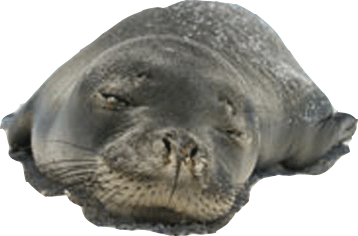Hawaiian Monk Seal

Scientific Classification
Kingdom: Animalia Phylum: ChordataClass: Mammalia
Order: Carnivora
Family: Phocidae
Genus: Monachus
Species: schauinslandi
Description
The Hawaiian monk seal is one of the rarest marine mammals in all over the world. Part of the "true seal" family, Phocidae, they are one of only two remaining monk seal species; the other is the Mediterranean monk seal. A third species, the Caribbean monk seal, is dead. Isolated from their closest relative 15 million years ago, Hawaiian monk seals are considered a "living fossil" because of their separate evolutionary lineage
Size
Monk seal females are slightly larger than males, with females reaching 7.5 feet (2.3 m) in length and 450 lbs (205 kg) and males reaching 7 feet (2.1 m) in length and 375 lbs (170 kg).
Diet
Hawaiian monk seals mainly eat fish, octopus, squid, and lobster.
Population
The current population of Hawaiian monk seals is now about 1,000 individuals.
Population Trends
There is one stock of bearded seals in U.S. waters: the Alaska stock. Early estimates of population size of the Alaska stock range from 250,000 to 300,000 animals. Current abundance and population trends of the U.S. stock are unknown.
Range
The Hawaiian monk seal occurs only in the Central Pacific, in the typically uninhabited northwestern Hawaiian Islands, with a small breeding population inhabiting the major Hawaiian Islands.
Distribution
The Hawaiian monk seal's entire range is in U.S. waters. The majority of monk seals live in six major breeding subpopulations in the Northwestern Hawaiian Islands (NWHI) at:
- Kure Atoll
- Midway Islands
- Pearl and Hermes Reef
- Lisianski Island
- Laysan Island
- French Frigate Shoals
Smaller breeding sub-populations also arise on Necker Island and Nihoa Island, and monk seals have been experiential at Gardner Pinnacles and Maro Reef.
 Deep Sea Crabs
Deep Sea Crabs